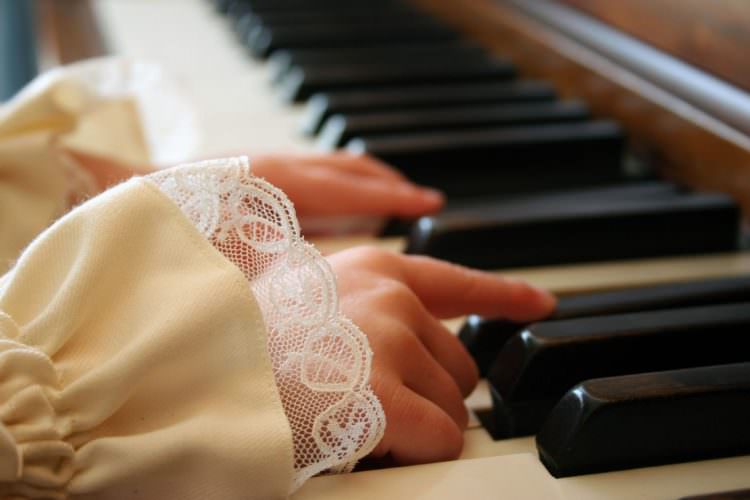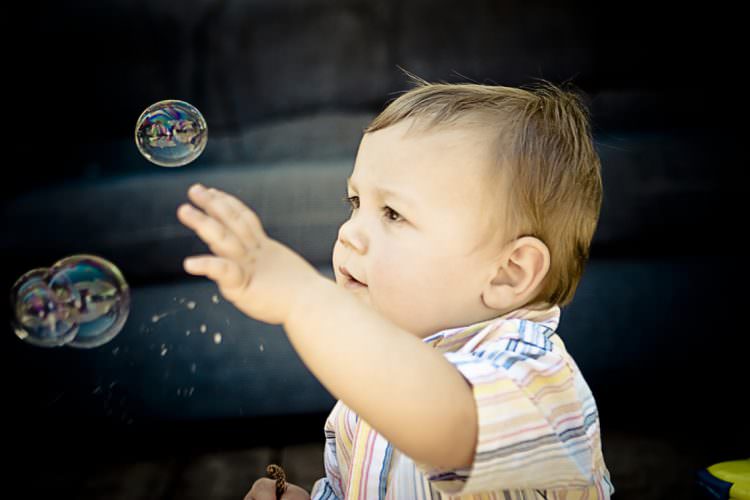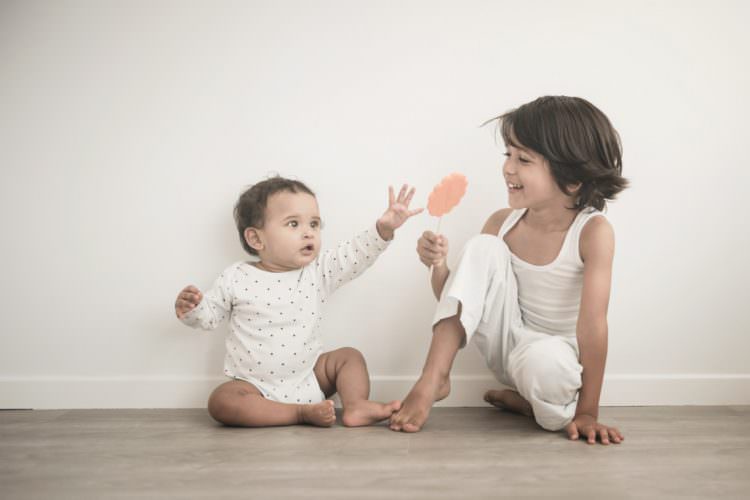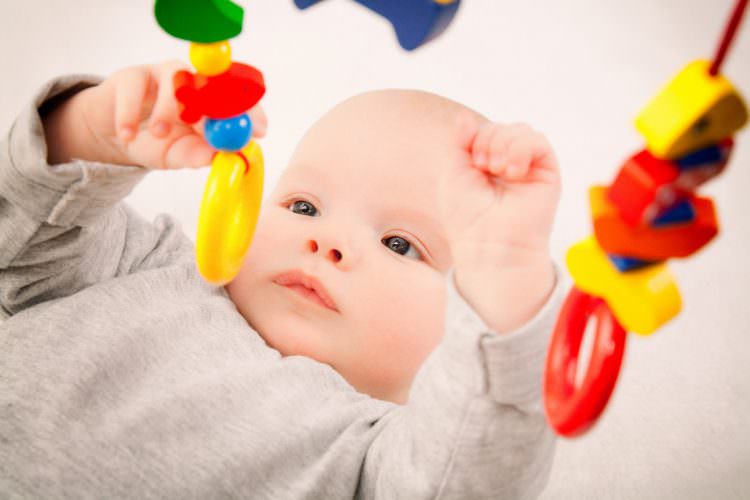Looking to learn more about how babies develop hand-eye coordination? Well, we can help! You’ll learn helpful exercises that encourage learning and growing.
What is Hand-Eye Coordination?
Hand-eye coordination is the cooperation between the eye and hand in order to guide both. As adults, we use this skill without really thinking about it. We grab our keys off the kitchen counter, we play video games, and we participate in sports. Without this skill, we would be unable to perform even the simplest of tasks.

Why is Hand-Eye Coordination Important?
While newborns are capable of reflexive grabbing, they are not yet able to coordinate between what they see and the use of their hands. Learning this critical ability engages both your child’s mental and physical development, and is a crucial component of both. The development of hand-eye coordination is one of your baby’s first opportunities to really interact with and manipulate the world around them. Plus, it helps them develop the confidence and independence that they will need to learn and grow.
Your baby’s ability to master hand-eye coordination is his first step to being able to feed and clothe himself, practice important life skills like writing, and achieve balance and coordination. While the exact timeline varies from child to child, you will see your baby start to experiment with this concept in early childhood- and there are things that you as their parent can do to help nurture and encourage this lifelong skill.
How Does ADAM & Mila Help Parents Encourage Developmental Success?
Our goal is to provide parents like you with the best information, tools, and activities possible so that you can be prepared for each stage of your little one’s life.
We’ll teach you the important hand-eye coordination milestones to expect through your baby’s development. Understanding your child’s experience and developmental milestones is important, as it will help guide you in how best to support their growth. Along with this knowledge, we’ll equip you with practical and easy to apply ideas for fun and educational activities.
How to Improve Hand-Eye Coordination
Like many of the other developmental skills your child will be learning early in life, good hand-eye coordination is achieved through play. Here, we’ll discuss what’s going on through the development of hand-eye coordination and ways you can encourage the coordinated development of their hand and eye movement.

Hand Movement
Your child will start life without strong body awareness. The grabbing and reaching you observe early in your child’s life is called primitive reflex, and is, as the name suggests, a reflexive response to external stimuli.
To help your child understand the cause-and-effect relationship between their movements and their environment, attach a rattle or a different noise-making toy to your child’s wrist. Early hand-eye coordination games such as these will help a child learn that their physical activity has effects on the outside world, and that their hands and body belong to them and are under their control.
Once your child starts exploring more with their hands, you’ll want to introduce activities that require him to use his fine motor skills. Your baby will initially reach for objects using their palm, but will be unable to pick up smaller objects this way. Allowing your child to interact with objects that require the use of their fingers will help them practice fine motor skills.
Learn more about fine motor skills
Eye Movement
Your baby’s eyes will provide the sensory input necessary to guide their hands. Baby vision, and your baby’s visual acuity (ability to perceive details) will improve rapidly during the first few months of their life.
However, many children experience some sort of vision impairment. If you observe delays in a child’s hand-eye coordination development such as slow reaction time or difficulty reaching for objects, their vision may be to blame. Vision therapy is available and effective for young children.
Brain Development
The brain is the center that processes visual input, translates thoughts into physical reactions, and allows sensory integration between the two. The motor activities your baby experiments while developing his hand-eye coordination also happens to be great brain exercises, and are improving the health of your child’s brain. Understanding how your child’s brain is developing during this time is an important part of understanding the development of hand-eye coordination.
You can learn and read more about your child’s brain development here
Putting It All Together
Improving hand-eye coordination will require the integration of your child’s physical, visual, and mental development. As these skills develop in coordination with each other, you will see your child move from more basic physical movements to more complex ones. Symmetric movement, or movement of both sides of your baby’s body symmetrically, will give way to bilateral integration, or a child’s ability to move each side of their body independently and cooperatively. Bilateral integration will then allow for manual dexterity, or a child’s ability to make coordinated efforts between their hands and fingers to manipulate objects.
An important part of your child’s ability to develop bilateral integration will be crossing the midline. The midline is the center of the body that separates the right and left sides. Children who struggle to bring their arms and legs across their midline are found to struggle with many other activities such as crawling, reading, and writing, because such a struggle signifies deficiencies in communication between the left and right hemispheres of the brain. If you notice your child using their right hand for activities that take place on the right side of the body, and then switching to their left when dealing with activities taking place on the left side, there are some things you can do to help encourage more bilateral integration. Playing simple games like twister and simon says are fun ways to help your child cross their midline spontaneously.
As they grow to become toddlers, children exhibit preference for a dominant hand and refine the coordination skills that they learned earlier in life. As they become more adept, you’ll want to introduce activities and toys that allow them to practice improved hand-eye coordination, such as playing catch the ball or doing kid yoga. If your child is not meeting their hand-eye coordination milestones, an occupational therapist may be able to identify the problem and work with your child to help them meet their goals.
Discover hands-on activities for toddlers that will help your child develop important life skills
Developmental Milestones
The following are milestones that you should expect your child to hit in early childhood. While every child is different, these milestones should happen around the age given for each.

Symmetric Arm Movement
Development Milestone emerges from age 0 to 2 months.
Your child’s arm and leg movements will be smooth and symmetrical at this stage. He’s not yet able to move the left side of the body without moving the right side, and he should not yet show preference for either.
Joining Hands at Midline
Development Milestone emerges from age 1 to 4 months.
Baby is bringing his hands together in a clapping motion. How cute!
To encourage this position, play a game of patty-cake with your little one, or place a favorite toy or bottle over his chest (his body midline). His hands should move together symmetrically.
Hand Clasping
Development Milestone emerges from age 3 to 5 months.
Once his hands are in the joined position over his midline, your baby may start to play with interlocking his fingers. Eventually, this will turn into hand clasping.
Related Activities
Maintaining Forward Head Position
Development Milestone emerges from age 4 to 5 months.
Your baby is able to turn and hold his head forward to look at objects directly in front of him. You can encourage baby to do this by holding items of interest at his midline.
Related Activities
Reaching with Both Hands
Development Milestone emerges from age 4 to 5 months.
Your child is not yet able to move his right hand without moving his left hand, so when he reaches for an object, he’ll reach with both hands.
Related Activities
Grabbing Bottle with Both Hands
Development Milestone emerges from age 4 to 6 months.
While he’s not yet able to hold his own bottle, your child will start to place his hands on his bottle while he is being fed.
Holding a Toy in Each Hand
Development Milestone emerges from age 5 to 6 months.
Your child is able to hold something in each hand, even if only for a few seconds.

To encourage this behavior, offer a child a small toy while they are already playing with something else. Both objects will need to be small, light, and easy to hold with one hand.
Related Activities
Reaching with One Hand
Development Milestone emerges from age 5 to 7 months.
Your child has figured out how to use one arm without moving the other, and he’ll begin reaching for small objects with one hand instead of both.
Related Activities
Switching Hands
Development Milestone emerges from age 5 to 7 months.
Moving a toy from one hand to another is an important step forward in your baby’s development. This behavior will start with your child clasping the item in both hands before transferring, but they will eventually be able to release one hand and grab with the other simultaneously.
Related Activities
Hitting Objects Against Each Other
Development Milestone emerges from age 8 to 12 months.
Building on some of the skills your baby has developed in recent months, he’ll start to bang objects together in front of his midline.
Related Activities
Opening a Present
Development Milestone emerges from age 10 to 12 months.
Let your child see you wrap a small item of interest, and then hand it to him. Your child should be able to unwrap the toy.
Related Activities
Using Both Hands Naturally
Development Milestone emerges from age 11 to 13 months.
At this stage your baby should be freely using both hands while playing. He may start to exhibit preferential use of one hand or the other, or hand dominance, but he should not be leaving out one hand altogether.
Related Activities
Using Hands Cooperatively
Development Milestone emerges from age 16 to 18 months.
You may start to notice your child’s preference for their dominant hand once he starts manipulating items that he is holding. Your child will use one hand to hold an object while exploring or using it with the other.
Related Activities
Your baby’s first years are full of exciting milestones and there is a lot that you can learn about these developmental milestones.
Tracking child developmental milestones allows you to be actively involved in your child’s growth, and can be fun. But what happens if your child isn’t reaching these milestones? As parents, this is a concern we all share. But there are things you can do to help your child meet their goals. We have an actionable guide to help you think of activities you can do to help your child succeed.
We hope that you have found the information and advice in this article helpful, and we encourage you to share this information with other parents that can benefit from it! We love to hear your feedback, so feel free to tell us what you think about this important subject in the comments.





well covered article.It’s inspired us.Thanks for sharing.